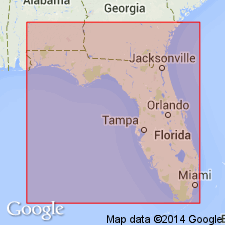
- Usage in publication:
-
- Avon Park limestone*
- Modifications:
-
- Original reference
- Dominant lithology:
-
- Limestone
- AAPG geologic province:
-
- Florida platform
Summary:
Pg. 1678 (table 1), 1680, 1686-1688. Avon Park limestone of Claiborne group. Name used for upper part of late middle Eocene which, in well samples, shows distinct faunal and lithologic characteristics. Mainly cream-colored highly microfossiliferous chalky limestone throughout its known extent. Thickness varies; 50 feet or less in northeast Florida where only basal part is present; 450 to 650 feet in southern part of peninsula. Underlies Ocala limestone; in region of Tallahassee overlies Tallahassee limestone (new), elsewhere overlies Lake City limestone (new). Tentatively correlated with Yegua formation (Claiborne). Avon Park limestone, Tallahassee limestone (with its equivalent nonfossiliferous facies), and Lake City limestone represent Claiborne group in peninsular Florida, and where all three units are present they appear to make, in most places, a conformable sequence.
Type well: at Avon Park Bombing Range, in sec. 31, T. 32 S., R. 30 E., Polk Co., east-central FL. Samples from well are indexed at No. W-668 in files of Florida Geological Survey. Surface outcrops in Citrus and Levy Cos.
Source: US geologic names lexicon (USGS Bull. 1200, p. 180).
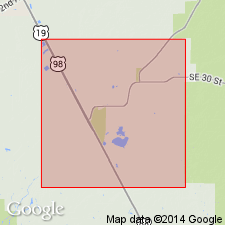
- Usage in publication:
-
- Avon Park limestone
- Modifications:
-
- Not used
- AAPG geologic province:
-
- Florida platform
Ericson, D.B., 1945, The Gulf Hammock formation in Florida: Science, v. 102, no. 2644, p. 234.
Summary:
Pg. 234. Avon Park limestone. Suggests abandoning name in favor of Gulf Hammock formation because outcrops have been discovered in Levy and Citrus Counties, Florida.
Source: US geologic names lexicon (USGS Bull. 1200, p. 180).
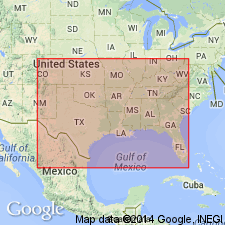
- Usage in publication:
-
- Avon Park limestone*
- Modifications:
-
- Areal extent
- AAPG geologic province:
-
- Florida platform
Summary:
Avon Park limestone. Used on correlation chart as name of surface formation. [Age is middle Eocene.]
Source: US geologic names lexicon (USGS Bull. 1200, p. 180).
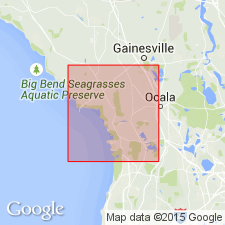
- Usage in publication:
-
- Avon Park limestone
- Modifications:
-
- Areal extent
- AAPG geologic province:
-
- Florida platform
Summary:
Pg. 95-111, pl. 1. Avon Park limestone of Claiborne group. Surface exposures described. As used in this report, Avon Park is a series of pasty to fragmental marine carbonate beds containing a distinct fauna and considerable amounts of peat, lignite, and plant remains. Unconformably underlies Inglis member (new) of Moodys Branch formation; unconformably overlies Lake City limestone. Name Gulf Hammock abandoned. Claiborne group. [Age is middle Eocene.]
Source: US geologic names lexicon (USGS Bull. 1200, p. 180).
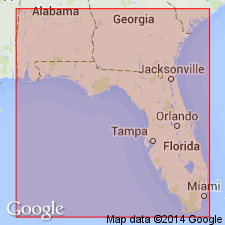
- Usage in publication:
-
- Avon Park Formation*
- Modifications:
-
- Revised
- Reference
- AAPG geologic province:
-
- Florida platform
Summary:
In subsurface, middle Eocene Avon Park Limestone changed to Avon Park Formation and stratigraphically extended to include the underlying Lake City Limestone, now abandoned in both south Georgia and peninsular Florida. Units cannot be distinguished from each other on the basis of either lithology or fauna. Name Avon Park is retained because unit was described on an earlier page in naming report for both units, and traditionally it has been applied to rocks whose lithology is different from the overlying Ocala Limestone. Includes brown limestone and dolomite between foraminiferal coquina or fossiliferous micrite of the Ocala and the gray micritic limestones and dolomites of the underlying Oldsmar Formation.
Reference section (well) designated in Levy Co., west-central FL. Depository of the well cuttings is the Florida Bureau of Geology, Tallahassee, stored as well no. 66.
Source: GNU records (USGS DDS-6; Reston GNULEX).
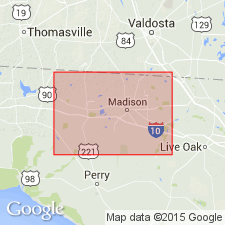
- Usage in publication:
-
- Avon Park Formation
- Modifications:
-
- Areal extent
- AAPG geologic province:
-
- Florida platform
Summary:
Authors follow nomenclature of Miller (1986) who revised the Avon Park to include the Lake City Limestone. Avon Park is oldest stratigraphic unit to crop out in Florida. Exposures are limited to areas in Levy and Citrus Counties. Unit forms the lower part of the potable Floridan aquifer system in Madison County. Occurs in subsurface throughout the county and can be observed in cuttings from 286 to 303 feet below MSL. In Madison County, formation is a moderately to well indurated limestone or dolomite. Frequently occurs as a very pale orange to white to light olive-gray, moderately porous, fossiliferous, gypsiferous, and fragmental limestone. Dolomite occurs as a brown to grayish brown moderately to well indurated, fossiliferous microcrystalline to very fine grained carbonate. Reportedly includes peat flecks in regions to the west in Jefferson County and to the southeast in the Florida peninsula, but no organic material was found in Madison County. Recorded thicknesses in county range from 80 to 220 feet. Unconformably(?) overlies the Oldsmar Limestone and underlies the Ocala Group.
Source: GNU records (USGS DDS-6; Reston GNULEX).
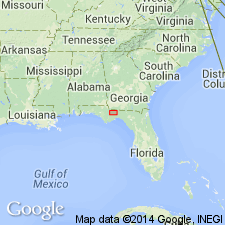
- Usage in publication:
-
- Avon Park Formation
- Modifications:
-
- Areal extent
- Dominant lithology:
-
- Limestone
- Dolomite
- AAPG geologic province:
-
- South Georgia sedimentary province
Summary:
Avon Park Formation includes the middle Eocene carbonates that occur in northern and peninsular Florida. [Miller (1986) grouped the lithologically similar Avon Park and Lake City Limestones of Applin and Applin (1944) into a single unit and that nomenclature is followed here.] Unit is age equivalent to the Lisbon Formation and Tallahatta Formation of the western panhandle of Florida. The Avon Park of the study area is difficult to recognize as it is transitional between the traditional highly fossiliferous cream to white to brown marine limestone and dolomite and the more glauconitic, sandy, and clayey limestones and sands of the Lisbon and Tallahatta Formations to the west.
Source: GNU records (USGS DDS-6; Reston GNULEX).
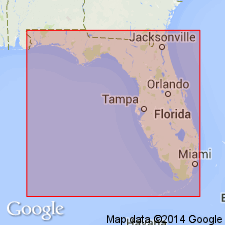
- Usage in publication:
-
- Avon Park Formation
- Modifications:
-
- Areal extent
- AAPG geologic province:
-
- Florida platform
Summary:
Author follows revisions of Miller (1986). The base of Miller's Avon Park at its reference section is a dolomite and can only be identified where it is underlain by identifiable limestone of the Oldsmar Formation. Where the base of the Avon Park is a limestone, the contact cannot be identified. Upper contact with Ocala can be identified lithologically except in areas where both are micrites. Author suggests that contrary to popular belief, no major unconformities from tectonic activity exist in south Florida and the boundaries between the Ocala and the under- and overlying units are simple facies changes. In southeastern Florida, where the Ocala appears to be missing the Avon Park lithology merges directly into the overlying Suwannee.
Source: GNU records (USGS DDS-6; Reston GNULEX).
For more information, please contact Nancy Stamm, Geologic Names Committee Secretary.
Asterisk (*) indicates published by U.S. Geological Survey authors.
"No current usage" (†) implies that a name has been abandoned or has fallen into disuse. Former usage and, if known, replacement name given in parentheses ( ).
Slash (/) indicates name conflicts with nomenclatural guidelines (CSN, 1933; ACSN, 1961, 1970; NACSN, 1983, 2005, 2021). May be explained within brackets ([ ]).

